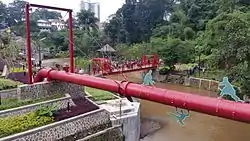| Cikapundung River | |
|---|---|
 The Cikapundung River at Taman Teras Cikapundung, Bandung | |
| Location | |
| Country | Indonesia |
| City | Bandung |
| Physical characteristics | |
| Mouth | |
• location | Confluence with the Citarum River |
• coordinates | 6°59′01″S 107°37′47″E / 6.98374°S 107.62983°E |
| Length | 28 km (17 mi) |
| Basin features | |
| River system | Citarum |
The Cikapundung River divides the city of Bandung, in West Java, Indonesia. The river flows from its headwaters in Lembang on the northern edge of the city, to the south, where it empties into the Citarum River.[1]
The name Cikapundung is derived from the Sundanese language, and means river (ci, cai: water) and the name of a type of fruit: kapundung or kepundung (Baccaurea racemosa).[2]
Despite being one of the main sources of Bandung's water supply,[3] the river is classified as heavily polluted.[4] Domestic waste, including human waste and detergents, is the main source of pollution as more people are living along the river banks. Other sources of pollutants are industry agriculture and farming.[4]
See also
References
- ↑ "Drama and Dilemmas on the Banks of the Cikapundung River". citarum.org (in Indonesian). Retrieved 2016-05-17.
- ↑ Noormansyah, Irfan. "Batuk Cikapundung ~ ceritamatakata". Retrieved 2016-05-17.
- ↑ Sabar, Arwin (2006-01-01). "Prospek Kontribusi DAS Cikapundung Memenuhi Laju Permintaan Sumber Air Baku Metropolitan Bandung". Media Komunikasi Teknik Sipil. 14 (2): 169–178. doi:10.12777/mkts.14.2.169-178 (inactive 1 August 2023). ISSN 0854-1809.
{{cite journal}}: CS1 maint: DOI inactive as of August 2023 (link) - 1 2 "Indonesia: Clean rivers needed to promote water and food security". World Bank. Retrieved 2016-05-17.
This article is issued from Wikipedia. The text is licensed under Creative Commons - Attribution - Sharealike. Additional terms may apply for the media files.